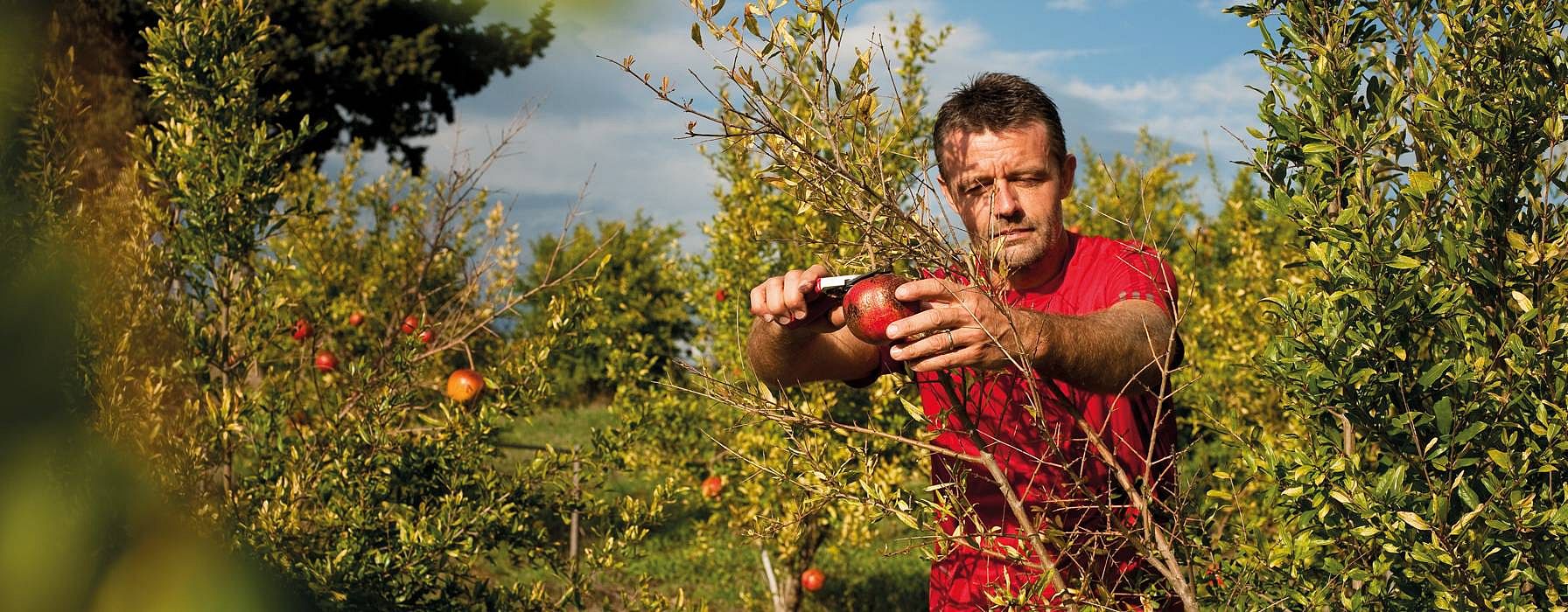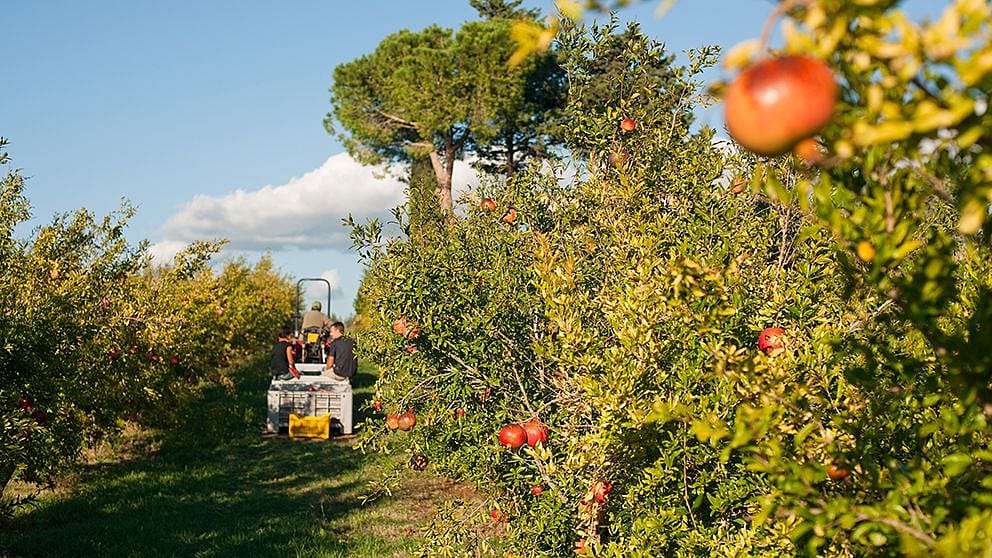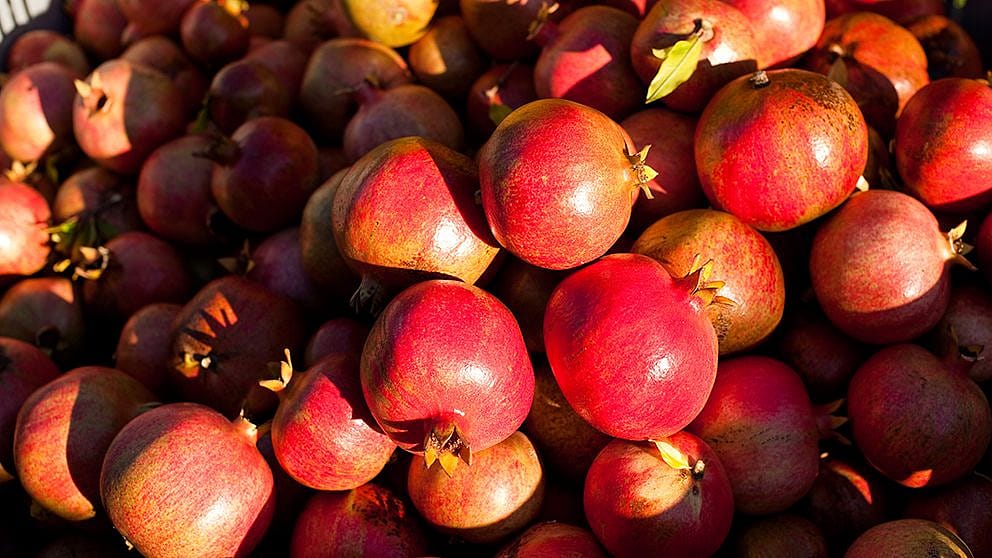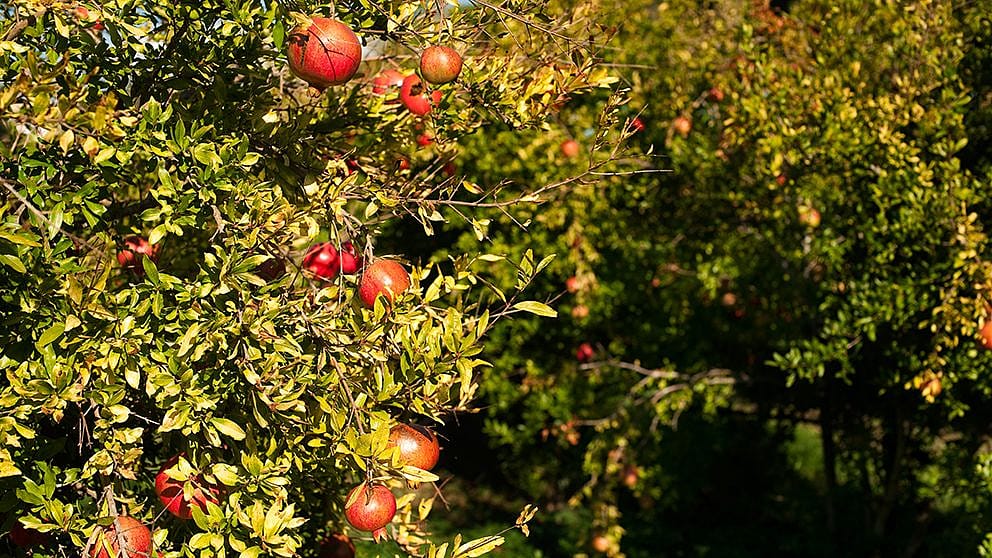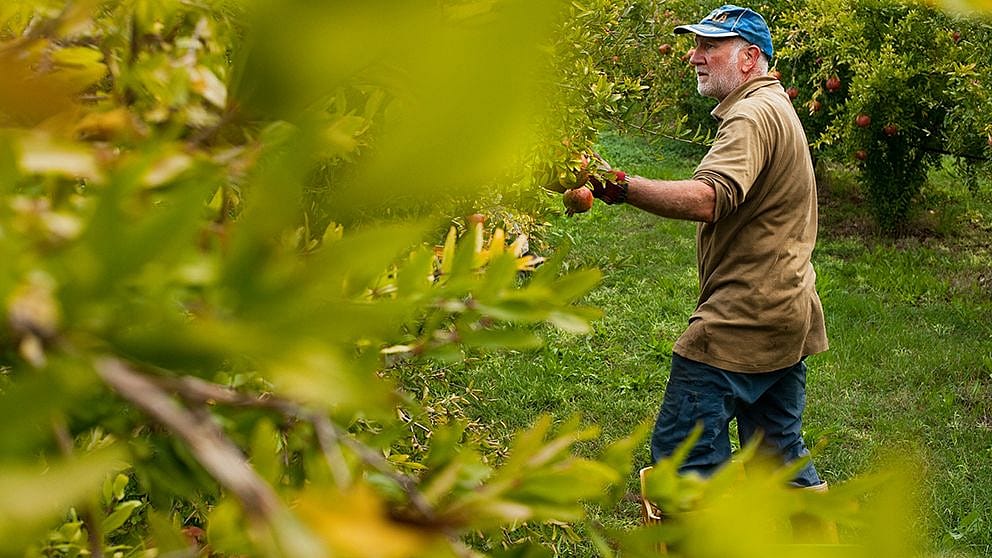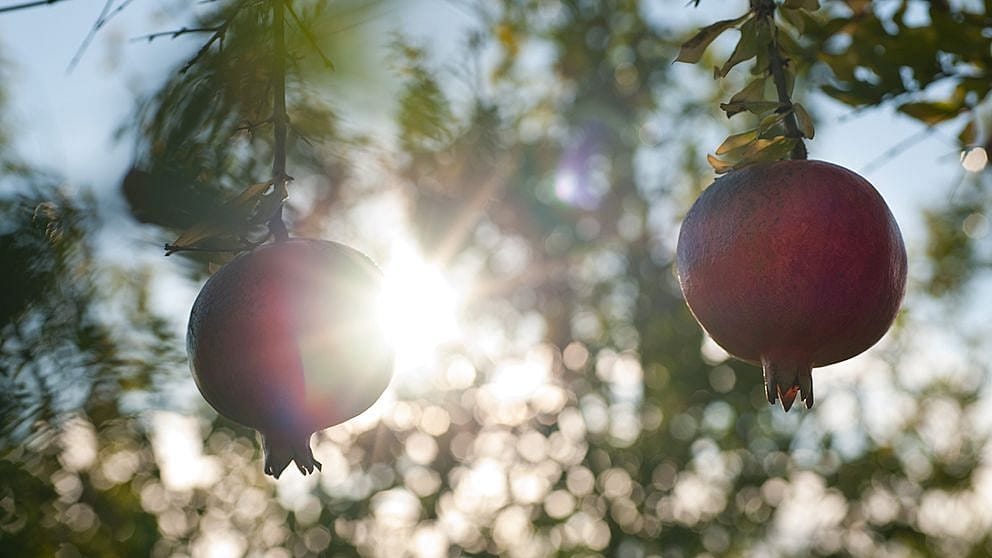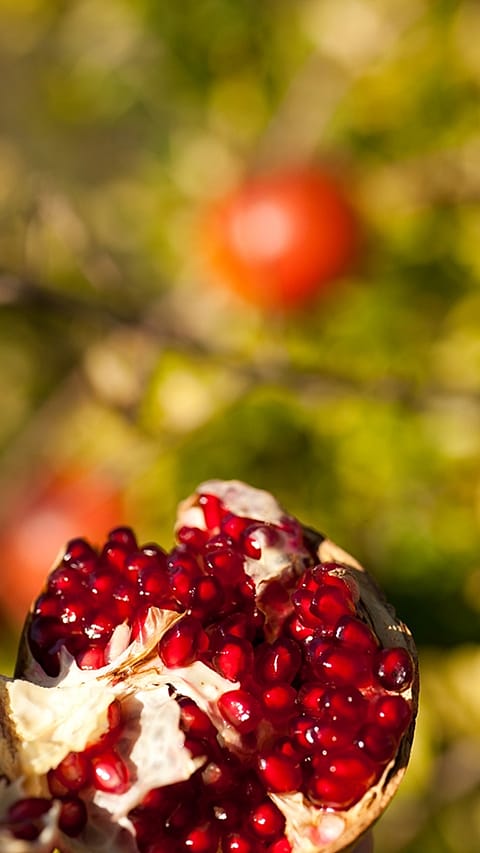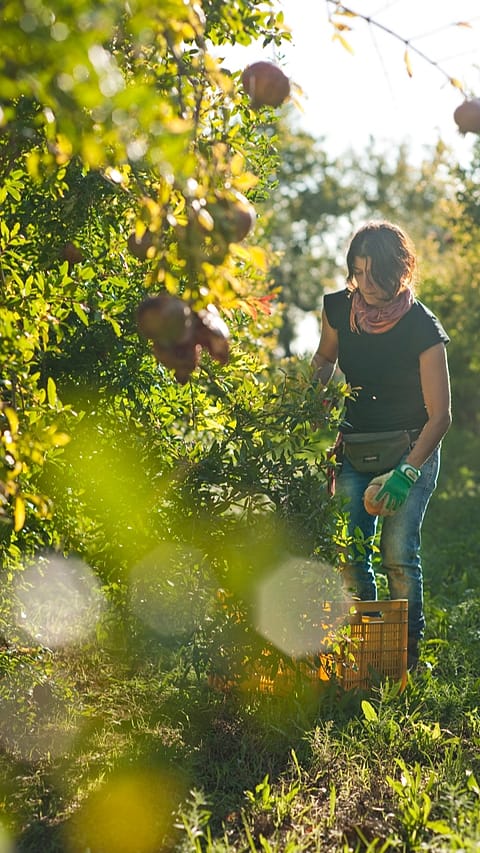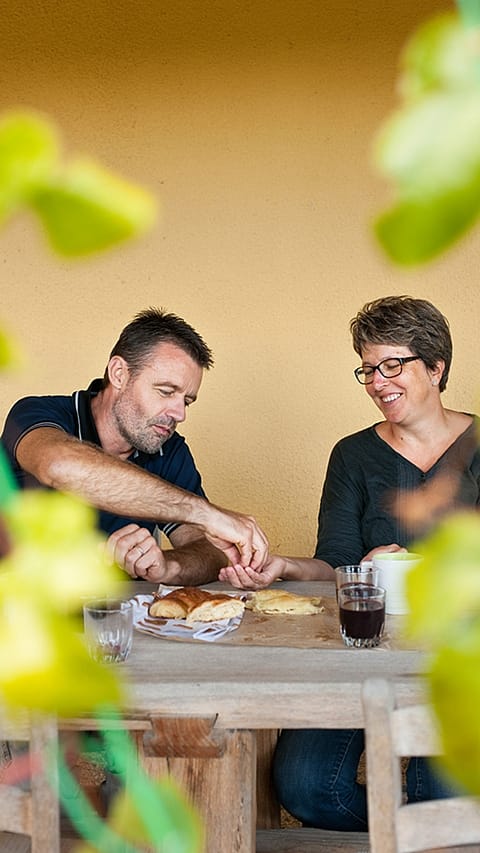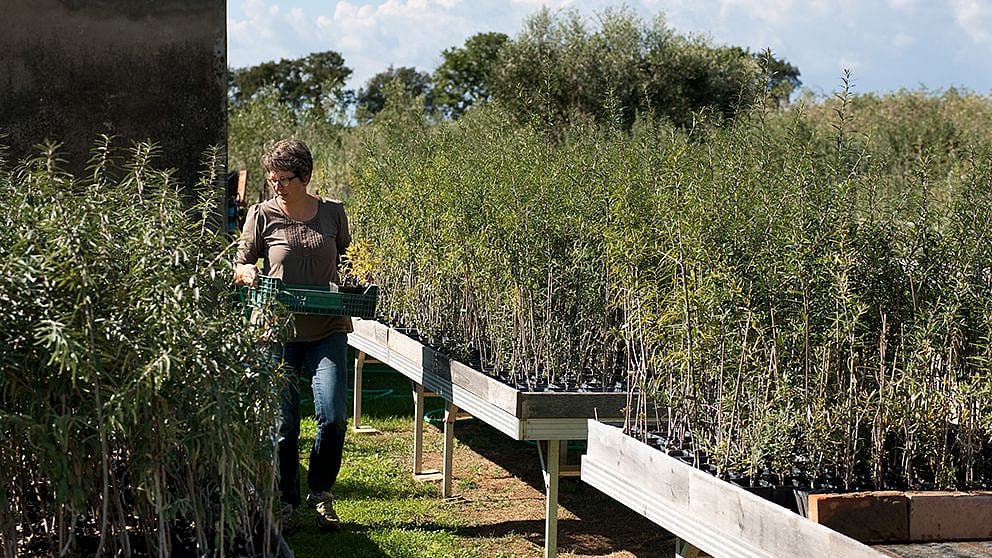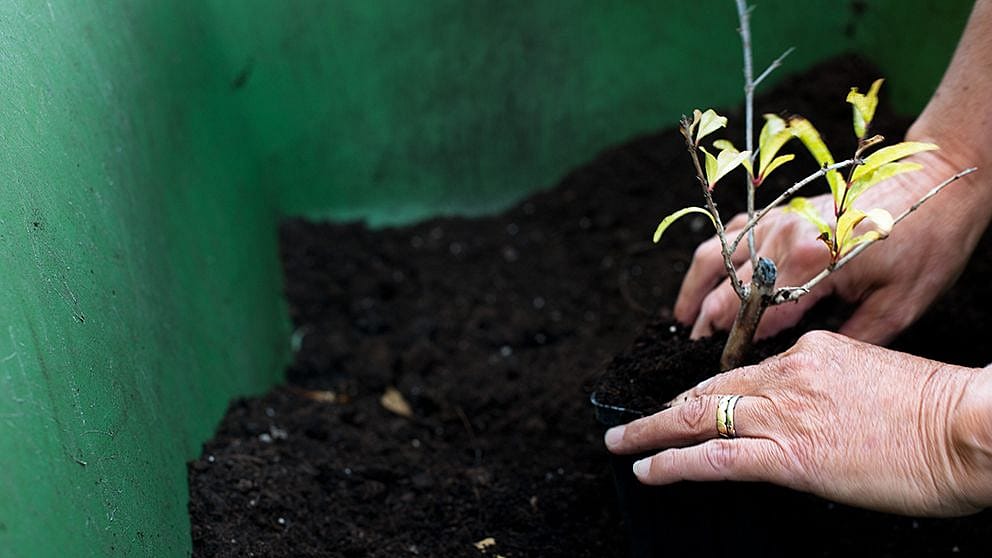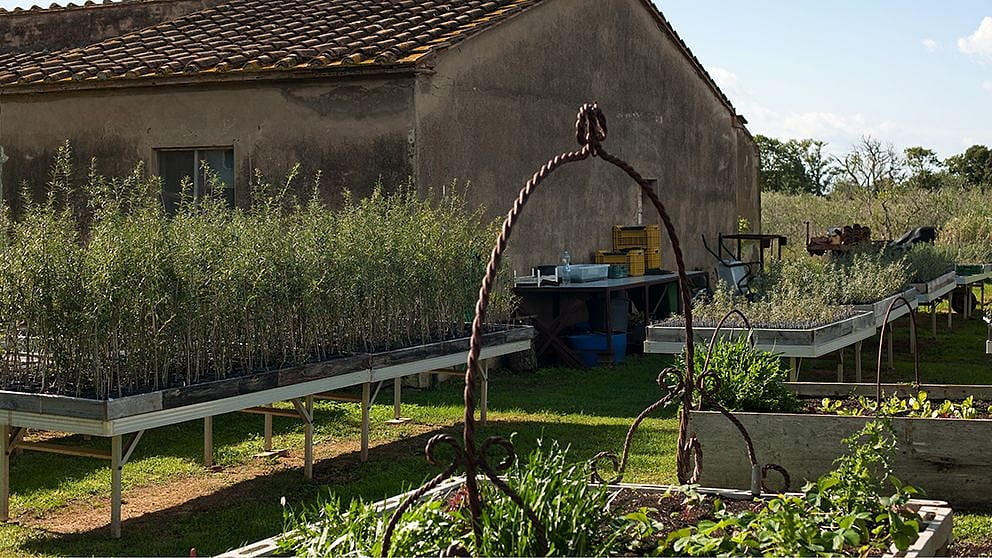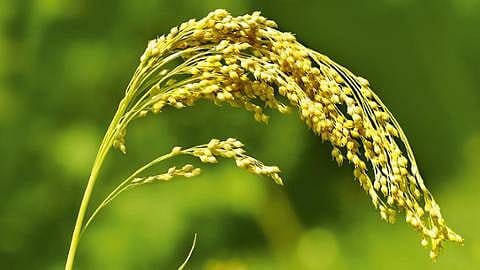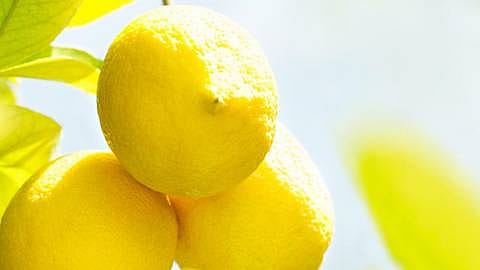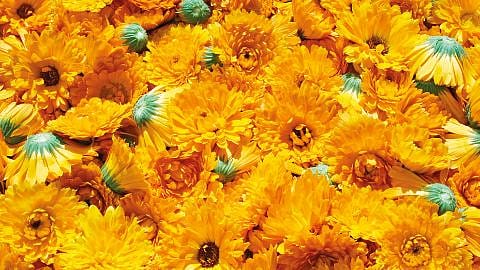Where Beauty Grows
Between the mountains and the sea, in the Italian province of Livorno, Tuscany, a unique microclimate prevails. Here on a farm, pomegranates are being cultivated and processed for their nutrient-rich juice. For those involved, the pomegranate harvest gives cause to celebrate.
The sky is clear and blue, and anything that might have previously hindered this has now been swept away by the wind blowing in from the nearby Etruscan coast. Like every morning, Fredy Röthlisberger’s SUV pulls up to the bright yellow-painted Bellavista manor house. Nestled in the midst of vast acreage, this is the administrative headquarters of Azienda Agricola San Mario, a Demeter-certified estate. A gravel path fringed by pine trees lies straight ahead, designed to capture and direct our attention.
But when he visits Bellavista on autumn days like this one, notes Fredy, this design aspect of the Tuscan manor just doesn’t seem to work. Inevitably, our focus drifts away from the pine trees and the manor house – to the left, beyond the young sea buckthorn shrubs and settles on the rows of plants that shine bright red from their midst. Or more accurately: the most beautiful, pomegranate red.
The pomegranate shrubs are planted in long rows, spaced 5 metres apart from one another and extending up to 150 metres in length. For the farm manager, it’s always a wonderful feeling to walk between them and enjoy the brilliant red fruits all for himself. As summer’s end nears, the colours and shapes of this lush cornucopia never cease to amaze him. Up to 50 pomegranates dangle like lanterns on each shrub, barely as tall as a grown person. And as if their general appearance weren’t impressive enough, at the bottom of each fruit is a little star, formed from the sepals of the flower bud. The branches bend low under their heavy load, some of them touching the ground. But relief approaches for the visibly strained branches, as suggested by the lively sound of voices just a few rows ahead.
Would picking them now deny them their final, energising rays of sun?
Fredy Röthlisberger
Promptly at half past seven in the morning, the workers begin with the harvest. “The timing is critical,” says Fredy, who wears trekking shoes and a three-day beard as he surveys his Tuscan garden with the familiarity of an urbanite who knows every nook of her kitchen balcony. Two weeks ago, the cicadas were still eagerly giving their concerts just ahead in the olive grove. But then, all at once, it became silent at Bellavista farm – outwardly, at least. Fredy says it feels as if he’s sitting on “pins and needles” during this transitional period, after the sea buckthorn has been harvested and before the olives are pressed. He walks along the pomegranate rows daily, turning the fruits to better assess them. Have they already reached full maturity? Do they threaten to burst open, should there be another cold night? Would picking them now deny them their final, energising rays of sun? Sometimes the workers must let everything else fall, when the time is ripe. It can depend on a matter of hours, says Fredy. And the fruit pulp, which protectively envelops the nutritious seeds, should preferably be deep red in colour – “It’s too early if it’s pink,” he says. Furthermore, if the fruit has already split open, it must be processed immediately, in order to preserve as much as possible of its beneficial nutrients.
Fredy and his staff use a hydraulic hand pump to process the pomegranates – it’s the gentlest method there is. It’s quite time consuming as well, and would take much too long if the harvest had to be processed all at once. But in the halls behind the yellow manor house, employees are busy from autumn until Christmas processing pomegranates, until there is no more fruit left – only juice.
This morning Fredy is visibly relaxed: as in the last few years, the timing was perfect. Again and again he reaches into the baskets on the floor, takes a fruit and carefully breaks it open. He nods and says that this is exactly how the sun-ripened fruits should be.
The farm workers are also in good cheer: for Marcella Pagliara, picking pomegranates off the trees is a beautiful and rewarding task. “Bello” – the Italian word for “beautiful” repeatedly escapes the lips of the wiry Italian woman with the raspy, melodic voice. She’s emphatic that it’s not only the beauty of the fruits, but also the activity of harvesting that she is referring to. Indeed, Marcella’s movements are almost dance-like, as she manoeuvres around the fruited bushes. She carefully positions her pruning scissors before snapping them closed, and then gently places yet another red orb into her harvesting basket.
It’s as if each fruit wants to be appreciated one last time, before leaving the garden. As if there should be a brief moment of silence and gratitude.
With flowing movements, the cheerful group of pickers progress metre by metre. There’s no sign of stress or boredom – perhaps because the size of the fruit makes it impossible to take more than one in the hand at a time. With each fruit, one must always begin anew: bending and carefully observing before finally picking. It’s as if each fruit wants to be appreciated one last time, before leaving the garden for the juice press. As if there should be a brief moment of silence and gratitude.
Among the workers are a horse trainer, a blacksmith and a former engineer, who was tired of his previous career and now feels more grounded through his new responsibilities on the farm. Fredy explains that he didn’t want completely unskilled labourers, but rather people who had an eye for nature.
Then another load is full. The trailer, which is more like a metal plate drawn by chains, glides across the grass without leaving a trace. Fredy designed the unconventional structure himself: the more intact and mineral-rich the soil, the better the plants which grow in it are cared for. Fredy ensures that the plants get only the best, so they can thrive here along the coast, southwest of the city of Pisa.
The pomegranate is like a child who is easy to care for and simply a joy
Fredy Röthlisberger
This region is famous for its unique microclimate – created in part by the Apennine mountain range that becomes visible from a few kilometres further inland. Winds blowing in from the Ligurian Sea stop when the reach the mountains, then turn around and cross back over the region a second time. The result is an ideal combination of sun, heat and wind that wine connoisseurs hold responsible for the excellent quality of the many local world-famous wines. This favourable combination of natural elements seems to benefit the pomegranate as well.
“The pomegranate is like a child who is easy to care for and simply a joy,” muses Fredy. For two consecutive summers, the olive trees were plagued by the olive fruit fly, and a hail storm once destroyed a part of his sea buckthorn crop. The pomegranate bushes, on the other hand, consistently display their brilliant red in early autumn, even if night frosts prevail as its first leaves begin to sprout in April.
The fruit had long fallen into obscurity in the region – despite being native to Italy. Isolated bushes could be glimpsed in front gardens or growing at the roadside. People no longer seemed to know what to do with pomegranates, other than to place them in the windowsill at Christmas or include them in wedding bouquets as a symbol of fertility. Until eight years ago, that is – when Kurt Künzi, Fredy’s now deceased father-in-law and a Swiss man like himself, decided to cultivate pomegranate for its health-fortifying juice. He had done the same with sea buckthorn when he established his farm in the late 1980s.
Today, his successor finds it important to remember the founding objective of Bellavista farm and the main estate, San Mario, just three kilometres away: to provide people with beneficial substances that strengthen the immune system. Sometimes it’s almost staggering when he looks at the rows of plants. One hundred hectares of vitamins, he thinks. Bellavista also sells directly to locals, who come regularly. People have said that the juice has improved their children’s concentration skills, and that it has spared the family from runny noses. Women have said that it has made the effects of menopause more tolerable .
Pomegranate and sea buckthorn are produced by San Mario as direct juice (not from concentrate); the company also produces sea buckthorn as a syrup. Some of the pomegranate juice is used in high quality skincare products. And it also ends up in the kitchen of many of the farm staff.
Before pomegranate juice production officially launched three years ago, there was a five-year test phase. Various irrigation methods and cultivation locations were considered, and there was much experimentation with the first small harvests. In the kitchen for instance: Irene Siegrist, who works in the office at Bellavista, raves about how pomegranate makes meat sauces wonderfully smooth and well coloured. And of the pomegranate seeds that she continues to use instead of raisins in her muffins.
Sun Power in a Glass
By now it’s noon, and time for a break. Like every day, Fredy drives back through the fields to the manor house at San Mario farm, located just a few kilometres away. Here the building is likewise painted bright yellow, with farmland all around. Fredy’s wife Martina waits on the veranda, surrounded by blossoming passion flowers. For lunch there’s turkey with carrots and salad. Martina Künzi comments that they are down-to-earth people, the kind who don’t actually need a driveway leading up to their house. But one can certainly have high standards when it comes to what we drink, adds her husband with a wink, as he sets down a glass carafe on the oak table. The colour alone of the sea buckthorn-pomegranate juice mixture within it is mesmerising. How can it be described – as fire-red, or purple-orange? “Let’s just say that Fredy has put summer on the table,” says Martina, and so it is. The power of the sun is inside this glass vessel, and up to 20 times more vitamin C than in orange juice, says Fredy. It’s something he should know, because he has analysed it himself, which he does regularly over at Bellavista’s in-house laboratory.
Bathtubs by the Wild Boars
While Fredy commutes regularly between both farms, Martina stays mainly at San Mario. At six in the morning, after closing the bedroom window to keep out the heat, Martina considers the work that lies ahead: 20,000 young plants, distributed across 70 planting tables. Tending the nursery
requires numerous hours of work – planting, transplanting, weeding and watering – Martina would rather avoid taking on any more work than that, she admits. Then she points out another interesting sight: near the pomegranates are large ditches the size of bathtubs, filled with rainwater.
Wild boars dug those ditches, and at first they were filled in again, on a nearly daily basis. This led to the animals digging new and even larger ditches during the following night. Finally, they simply left the ditches alone – and so did the boars. Now only a few such ditches remain. Building a fence would have been contrary to the biodynamic principle, which sees nature as something continuous, explains Martina. San Mario’s fields are naturally enclosed by hedges and small groves of holm oaks, which offer shelter to an abundance of different birds. The scops owl, the red-backed shrike and a large inventory of pheasants are among those that live here.
A Vision Becomes Reality
Sometimes 49-year-old Martina thinks back to how it all began. How, as a child, she visited Italy with her parents on holiday, and how her father wanted to live the Tuscan dream. But not in the sense of kicking back and putting on the bathing suit. Instead, his was a desire to know the region’s unique and natural landscape, experiencing the villages and collecting herbs. Today, Martina carries on her father’s dream. And she’s long been doing so with Fredy, who at 22 began accompanying his then-girlfriend’s father to remote corners of Switzerland in search of wild sea buckthorn for cultivation. They searched in climates where the plants best grow, and where people seem to understand that they are part of the cosmos, where life is more than just consuming, but about working and taking the time to pause and be amazed. Where this amazement comes at the latest in autumn, when the pomegranate calls for attention.
